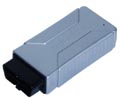- Gas Recirculation
- |
- Electrical Actuators
- |
- Repair Basics
- |
- Technical Info
- |
- Car Tech Info
- |
- MicroTronik
Exhaust Gas Recirculation

EGR System Control Operation

EGR System Control Types
1. Function
Exhaust gas contains NOx that is hazardous to human central nervous system and mucous membrane, as well as is globally principal cause for photochemical smog, and therefore globally subject to increasingly strong regulation together with HC and CO. As CO and HC are resulting from imperfect combustion, improved combustion will improve engine performance, too. However NOx increases as combustion maximum temperature and in particular rapidly increases typically above 2000 Degree C of combustion temperature, combustion maximum temperature shall be lowered in order to decrease NOx.
As lowering combustion maximum temperature is an effective way to actually reducing NOx, they partly recirculates exhaust gas (approx. 15% of intake mixture) to take initial gas (CO2) into combustion chamber. Then recirculates exhaust gas will not burn and therefore combustion temperature at explosion will be decreased to reduce NOx significantly (max. 60%). However EGR will degrade ignition characteristics of the mixture and consequently reduce engine output, though EGR is effective for NOx reduction. In addition HC and CO in emission gas may increase, if EGR rate is not appropriate. Therefore it is important to take operation range in which much NOx is generated, and recirculates proper quantity of exhaust gas in the range.2. Configuration and Operation Principle
When vacuum pressure occurs at vacuum port located near to throttle valve, the pressure will be delivered through vacuum hose, and nipple to vacuum chamber. Then the pressure will operate on vacuum pressure chamber diaphragm and consequently push up needle valve that is combined with the diaphragm, from valve seat, making gap. The gap will then provide route for exhaust gas going into intake manifold, and depending on the vacuum pressure applied to vacuum pressure chamber of the EGR valve, needle valve lift and consequently exhaust gas route area varies. Proper control of vacuum pressure applied to vacuum pressure chamber of EGR valve depending on engine operation condition, will provide optimal EGR.
3. EGR System Control Types:
Depending on vacuum chamber of the EGR valve, vacuum pressure control type, vacuum pressure controlled type may be classified into mechanical type that typically use low EGR of EGR rate, 5~15 %, and electronic control type use high EGR of EGR rate, above 15 %.(1) Vacuum Pressure Controlled Type
It is the most basic control type that controls EGR valve using vacuum pressure generated near to throttle valve. In idling or with throttle valve wide open, vacuum of the port will be low enough to be defeated by spring force of the EGR diaphragm, and then EGR valve will close and quit EGR. Otherwise EGR rate that is recirculated through EGR valve to intake manifold will be decided depending on magnitude of port vacuum.
(2) Back Pressure Controlled Type
This type controls EGR valve depending on the finding that there is almost typical relation between exhaust gas back pressure and air intake rate.
BPT (Back Pressure Transducer) valve controls EGR vacuum pressure to maintain and orifice downstream vacuum always constant. Then EGR quantity will be proportional to air intake rate, and EGR rate will be decided depending on orifice section area.
When throttle valve opens, port (E) vacuum will rise and then defeat spring force of the EGR valve vacuum chamber consequently resulting to EGR valve opening. Therefore exhaust gas will be recirculated to intake manifold making pressure of the venturi part decrease. When pressure of the venturi part decreases to atmospheric pressure, BPT will open connecting between port (E) vacuum and port (A) (atmospheric pressure), and then EGR valve will close. Upon EGR valve closing, back pressure will rise to close. Therefore port (E) vacuum will be applied to vacuum pressure chamber of the EGR valve, and then EGR valve will open recirculating exhaust gas to intake manifold. Repeating this operation, EGR rate will be controlled properly responding to air intake rate.
(3) Electronic Controlled Type
This type uses engine operating condition data detected by various sensors and signals provided by microprocessor, in order to operate actuator and then control EGR valve opening.
(4) Solenoid Valve
EGR SOL/VLV relies on electromagnet principle, and consists of coil, core, and yoke which generate magnetic field, plunger and valve seat which open/close air flow and orifice which controls flow rate.
The operating principle is: When ECU manages to approve power supply at EGR, electromagnetic force will be generated around coil making core a electromagnet, that will pull plunger closing flow route, then power supply will be cut off, and spring force will re-open the flow route.
You can check the actuator actual value and status and activate it when it is possible by AutoHex Diagnostic Scanner under the supported car brand and according to engine type.
Key learning when all keys lost
Description
Exhaust gas contains NOx that is hazardous to human central nervous system and mucous membrane, as well as is globally principal cause for photochemical smog, and therefore globally subject to increasingly strong regulation together with HC and CO. As CO and HC are resulting from imperfect combustion, improved combustion will improve engine performance, too.
Autohex II Reviews
AutoHex II
AutoHex II is your best choice to have full access to dealer functions like coding, adjusting and modules flashing/programming, Contact us for prices
AutoHex Forum


